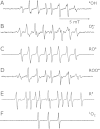Multiple free-radical scavenging capacity in serum
- PMID: 22962529
- PMCID: PMC3432821
- DOI: 10.3164/jcbn.11-113
Multiple free-radical scavenging capacity in serum
Abstract
We have developed a method to determine serum scavenging-capacity profile against multiple free radical species, namely hydroxyl radical, superoxide radical, alkoxyl radical, alkylperoxyl radical, alkyl radical, and singlet oxygen. This method was applied to a cohort of chronic kidney disease patients. Each free radical species was produced with a common experimental procedure; i.e., uv/visible-light photolysis of free-radical precursor/sensitizer. The decrease in free-radical concentration by the presence of serum was quantified with electron spin resonance spin trapping method, from which the scavenging capacity was calculated. There was a significant capacity change in the disease group (n = 45) as compared with the healthy control group (n = 30). The percent values of disease's scavenging capacity with respect to control group indicated statistically significant differences in all free-radical species except alkylperoxyl radical, i.e., hydroxyl radical, 73 ± 12% (p = 0.001); superoxide radical, 158 ± 50% (p = 0.001); alkoxyl radical, 121 ± 30% (p = 0.005); alkylperoxyl radical, 123 ± 32% (p>0.1); alkyl radical, 26 ± 14% (p = 0.001); and singlet oxygen, 57 ± 18% (p = 0.001). The scavenging capacity profile was illustrated using a radar chart, clearly demonstrating the characteristic change in the disease group. Although the cause of the scavenging capacity change by the disease state is not completely understood, the profile of multiple radical scavenging capacities may become a useful diagnostic tool.
Keywords: ESR spin trapping; MULTIS; chronic kidney disease; multiple free radical; serum.
Figures


References
-
- McCord JM, Wong K. Oxygen free radicals and tissue damage. Excerpta Medica. 1979;65:343–351.
-
- Halliwell B, Gutteridge JMC. Free radicals in biology and medicine. Tokyo: Japan Scientific Societies Press; 1988.
-
- Glazer AN. Phycoerythrin fluorescence-based assay for reactive oxygen species. Methods Enzymol. 1990;186:161–168. - PubMed
-
- Cao G, Alessio HM, Cutler RG. Oxygen-radical absorbance capacity assay for antioxidants. Free Radic Biol Med. 1993;14:303–311. - PubMed
-
- Benzie IF, Strain JJ. The ferric reducing ability of plasma (FRAP) as a measure of ”antioxidant power”: the FRAP assay. Anal Biochem. 1996;239:70–76. - PubMed
LinkOut - more resources
Full Text Sources
Miscellaneous

